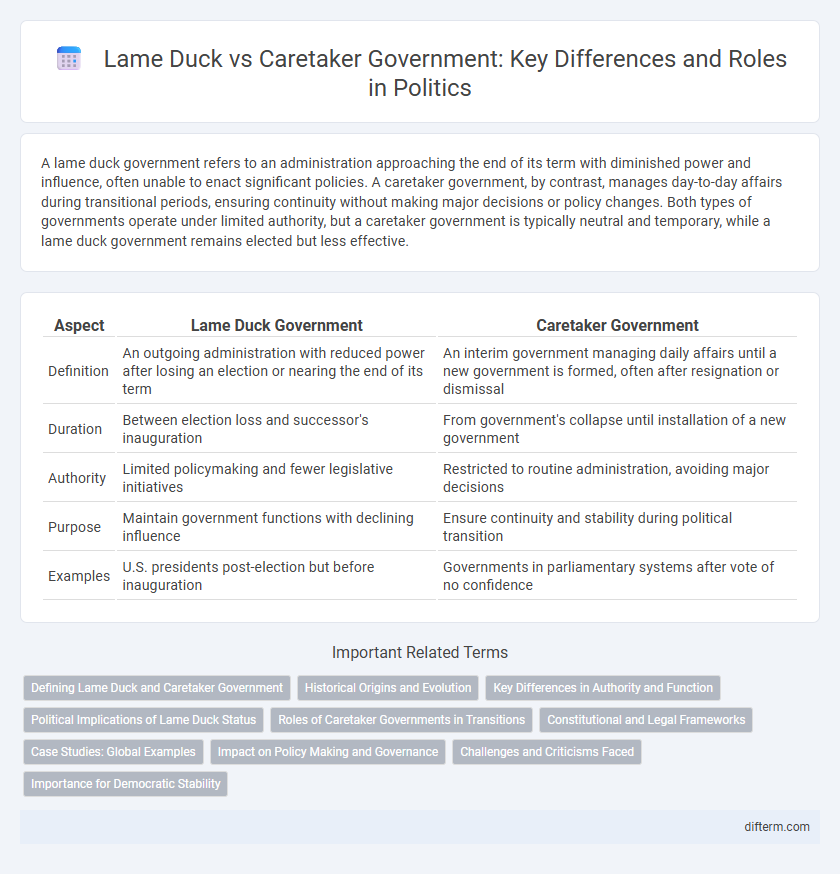A lame duck government refers to an administration approaching the end of its term with diminished power and influence, often unable to enact significant policies. A caretaker government, by contrast, manages day-to-day affairs during transitional periods, ensuring continuity without making major decisions or policy changes. Both types of governments operate under limited authority, but a caretaker government is typically neutral and temporary, while a lame duck government remains elected but less effective.
Table of Comparison
| Aspect | Lame Duck Government | Caretaker Government |
|---|---|---|
| Definition | An outgoing administration with reduced power after losing an election or nearing the end of its term | An interim government managing daily affairs until a new government is formed, often after resignation or dismissal |
| Duration | Between election loss and successor's inauguration | From government's collapse until installation of a new government |
| Authority | Limited policymaking and fewer legislative initiatives | Restricted to routine administration, avoiding major decisions |
| Purpose | Maintain government functions with declining influence | Ensure continuity and stability during political transition |
| Examples | U.S. presidents post-election but before inauguration | Governments in parliamentary systems after vote of no confidence |
Defining Lame Duck and Caretaker Government
A lame duck government refers to an administration whose power is waning after a successor has been elected, limiting its ability to enact significant policies. In contrast, a caretaker government operates in a temporary capacity, managing day-to-day affairs without making major decisions, often during election periods or transitional phases. Both entities play distinct roles in political stability and governance continuity during periods of power transition.
Historical Origins and Evolution
Lame duck and caretaker governments both originate from historical needs to manage political transitions without full authority. The term "lame duck" dates back to 18th-century British Parliament, originally describing ineffective members nearing the end of their term, while caretaker governments evolved as interim administrations maintaining basic governance during election periods or political crises. Over time, these concepts have adapted to modern democracies, emphasizing limited power and ensuring stability until duly elected officials assume office.
Key Differences in Authority and Function
A lame duck government operates with diminished authority after an election but before the new administration takes office, often limiting its capacity to enact significant policies. In contrast, a caretaker government is appointed to manage day-to-day affairs during a transitional period, focusing on maintaining stability without initiating major legislative changes. The key difference lies in the lame duck's residual authority despite reduced influence, whereas the caretaker government functions under strict neutrality with minimal policy intervention.
Political Implications of Lame Duck Status
Lame duck governments face diminished political influence due to limited decision-making power, often resulting in stalled legislation and weakened negotiation capabilities. The perception of reduced authority can embolden opposition parties and limit the administration's ability to implement significant policy changes before the new government assumes office. This transitional period highlights challenges in governance continuity and strategic planning within the political landscape.
Roles of Caretaker Governments in Transitions
Caretaker governments play a crucial role in maintaining stability and continuity during political transitions by managing day-to-day administrative functions without making major policy decisions. Their primary responsibility is to organize free and fair elections, ensuring an impartial environment for the transfer of power. They also act as neutral stewards, preventing any manipulation of governance that could unfairly advantage incoming administrations.
Constitutional and Legal Frameworks
In constitutional frameworks, a lame duck government retains full executive powers but faces limited political influence after losing electoral legitimacy, often constrained by legal norms and parliamentary oversight. Conversely, a caretaker government operates under specific constitutional provisions, focusing on routine administration and avoiding major policy decisions until the new government is formed. Legal frameworks typically mandate caretaker status post-elections or during government transitions to ensure continuity while upholding democratic legitimacy.
Case Studies: Global Examples
Lame duck and caretaker governments differ significantly in global political contexts, with notable case studies such as the 2010 U.S. Congress lame duck session, where outgoing legislators passed critical legislation before the new term, and the 2013 Italian caretaker government led by Enrico Letta, which managed state affairs without initiating major policy changes. In the United Kingdom, caretaker governments follow general elections when no party commands a majority, exemplified by the 2017 period before Theresa May's minority government formation, maintaining essential functions without strategic shifts. These case studies highlight how lame duck governments often exert final legislative influence, while caretaker administrations prioritize administrative continuity and neutrality during transitional phases.
Impact on Policy Making and Governance
Lame duck governments often face diminished influence on policy making due to reduced political capital and legislative support, leading to stalled reforms and decreased government effectiveness. Caretaker governments, by constitutional design, are limited to routine administration and avoid major policy decisions to maintain neutrality during transition periods. Both impact governance by creating periods of policy inertia, yet caretaker governments preserve institutional stability while lame duck administrations may provoke uncertainty and hinder long-term planning.
Challenges and Criticisms Faced
Lame duck governments often face challenges due to diminished political influence and limited legislative effectiveness, making it difficult to implement policies or respond to crises. Caretaker governments encounter criticisms for their restricted authority, especially in managing urgent affairs or making long-term decisions during transitional periods. Both structures struggle with legitimacy concerns and public confidence, impacting governance stability during sensitive political phases.
Importance for Democratic Stability
Lame duck governments experience limited power and reduced policy-making capacity after elections, potentially leading to political inertia that can undermine democratic stability. Caretaker governments, by contrast, maintain essential governance functions during transitional periods while respecting electoral mandates, thereby preserving public trust and institutional continuity. Ensuring clear legal frameworks for caretaker roles is crucial to prevent power vacuums and foster democratic resilience during political transitions.
Lame duck vs Caretaker government Infographic

 difterm.com
difterm.com